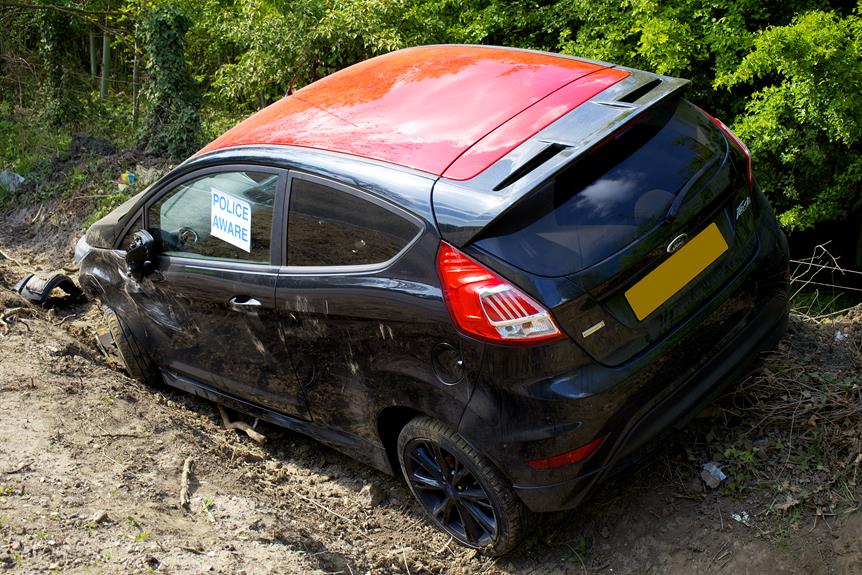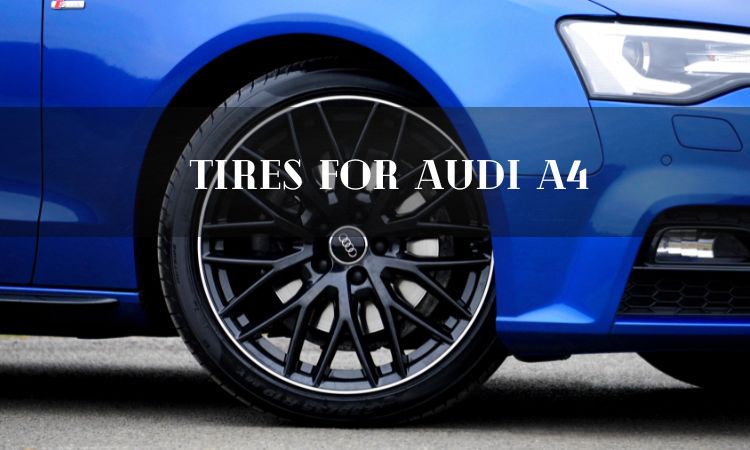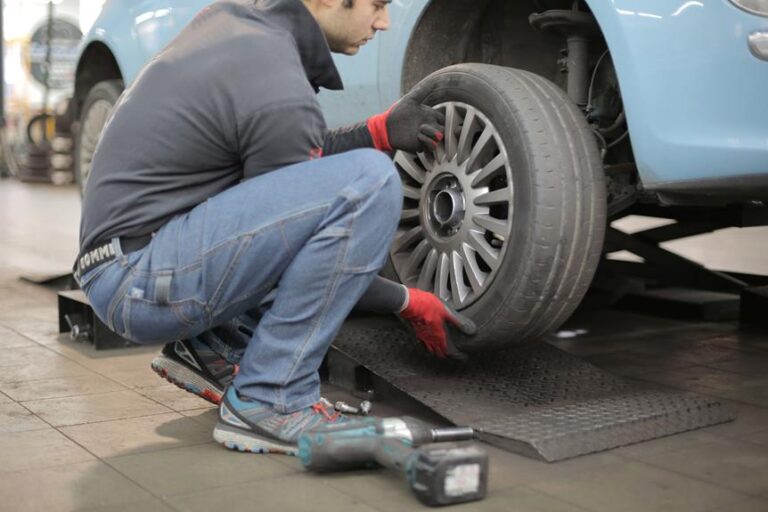Safeguarding Your Tires From Sidewall Damage
In the race to safeguard your vehicle's tires from the perils of sidewall damage, knowledge is the fuel that propels you forward.
As the saying goes, 'Prevention is better than cure.' To arm yourself with the necessary knowledge, this article serves as your pit crew, providing detailed insights and authoritative guidance on choosing the right tires, maintaining proper tire pressure, and avoiding road hazards.
By taking these precautions, you can ensure the freedom to enjoy the open road with tire sidewalls that remain unscathed.
Key Takeaways
- Regularly inspect your tires for signs of damage or wear to identify potential sidewall issues.
- Maintain proper tire pressure to distribute the weight of your vehicle evenly and reduce stress on the sidewalls.
- Choose tires with protective coatings, reinforced sidewalls, or advanced materials to enhance sidewall durability.
- Seek professional help for sidewall repair or replacement to ensure the safety and longevity of your tires.
Understanding the Causes of Sidewall Damage
In order to effectively prevent sidewall damage, it is essential to have a thorough understanding of the causes behind such issues. Sidewall damage can occur due to a variety of factors, and being aware of these causes can help car owners take the necessary steps to prevent tire damage and ensure their safety on the road.
One common cause of sidewall damage is driving over rough terrain or encountering sharp objects on the road. Potholes, debris, and curbs can all pose a risk to the sidewall of a tire, leading to cuts, punctures, or even sidewall bulges. To prevent such damage, it is important to practice safe driving habits and avoid rough roads whenever possible.
Another cause of sidewall damage is underinflation or overinflation of tires. When a tire is not inflated to the manufacturer's recommended pressure, it can put excessive stress on the sidewall, leading to cracking, bulging, or even blowouts. Regular tire maintenance, including checking the air pressure and inflating the tires to the correct level, is crucial in preventing sidewall damage.
Furthermore, sidewall damage can also occur due to aging and deterioration of the tire. As tires get older, the rubber can become brittle and develop cracks, making the sidewall more susceptible to damage. Regular inspection of the tires for signs of wear and tear is important in identifying any potential issues and replacing the tires when necessary.
Choosing the Right Tires for Sidewall Protection
To ensure optimal sidewall protection, car owners must carefully select tires that not only meet their specific driving needs but also provide enhanced resistance against potential damage. The sidewalls of tires are vulnerable to various forms of damage, including punctures, cuts, and scrapes. Therefore, choosing the right tires is crucial for maintaining the safety and longevity of your vehicle.
Here are three factors to consider when selecting tires for sidewall protection:
- Protective Tire Coatings: Look for tires that come with a protective coating on the sidewalls. These coatings are designed to provide an extra layer of defense against abrasions and impacts, helping to prevent sidewall damage. Additionally, these coatings can also enhance the overall appearance of your tires.
- Choosing the Right Tire Size: It is essential to select the correct tire size for your vehicle. Using the manufacturer-recommended tire size ensures proper fitment and alignment, reducing the risk of sidewall damage. Incorrect tire sizes can lead to increased stress on the sidewalls, making them more susceptible to punctures and cuts.
- Tire Construction: Consider the construction of the tires you are considering. Look for tires that are specifically designed for sidewall protection, such as those with reinforced sidewalls or advanced materials that offer increased durability.
Maintaining Proper Tire Pressure to Prevent Sidewall Damage
Maintaining optimal tire pressure is crucial for preventing sidewall damage. It helps distribute the weight of the vehicle evenly and reduces the risk of excessive stress on the sidewalls.
Regular tire maintenance is essential to ensure the longevity and safety of your tires. One important aspect of tire maintenance is using the right tire gauge to accurately measure the tire pressure.
Choosing the right tire gauge is vital to ensure accurate readings. There are a variety of tire gauges available in the market, ranging from digital to analog, and each has its own advantages. Digital gauges provide precise readings and are easy to read, while analog gauges are durable and do not require batteries. It is important to choose a gauge that suits your needs and preferences.
Regular tire maintenance, including checking and adjusting tire pressure, should be performed at least once a month. This routine maintenance not only prevents sidewall damage but also improves fuel efficiency and enhances overall vehicle performance. Neglecting tire pressure can lead to uneven tire wear, reduced traction, and increased risk of blowouts.
Avoiding Potholes and Road Hazards
Regularly inspecting your tires for any signs of damage or wear, and taking proper precautions such as avoiding potholes and road hazards, can significantly reduce the risk of tire blowouts and other potential safety hazards. In addition to these preventive measures, there are other steps you can take to ensure the longevity and performance of your tires:
- Importance of regular tire rotations: Tire rotations involve moving the tires from one position to another to ensure even wear. This helps to extend the lifespan of your tires and maintain optimal traction and handling. It is recommended to have your tires rotated every 5,000 to 8,000 miles or as advised by your vehicle manufacturer.
- Tips for avoiding tire blowouts: Tire blowouts can be dangerous and often occur due to underinflated tires or excessive heat buildup. To avoid blowouts, it is crucial to regularly check and maintain proper tire pressure, as recommended by your vehicle manufacturer. Additionally, avoid overloading your vehicle beyond its specified capacity and reduce your speed when driving over potholes or road hazards.
Using Wheel and Tire Protection Products
One way to protect your investment in wheel and tire protection products is by regularly cleaning them with a gentle, non-abrasive cleaner and a soft cloth. Proper wheel and tire maintenance not only enhances the appearance of your vehicle but also ensures optimal performance and longevity. Wheel and tire protection products offer additional benefits that can help safeguard your investment.
These products provide a protective barrier against various environmental elements such as dirt, grime, and UV rays. They also help prevent damage from road debris, chemicals, and brake dust. By creating a barrier, these products make it easier to clean and maintain your wheels and tires.
In addition to protection, wheel and tire protection products can also enhance the overall performance of your vehicle. They can improve fuel efficiency by reducing rolling resistance and optimizing tire traction. Furthermore, these products can extend the lifespan of your tires by preventing cracking, fading, and premature wear.
To illustrate the benefits of wheel and tire protection products, the table below highlights some key features and advantages:
| Features | Advantages |
|---|---|
| Protection against dirt, grime, and UV rays | Preserves the appearance of your wheels and tires |
| Shields against road debris and brake dust | Reduces the risk of damage and corrosion |
| Enhances fuel efficiency | Improves mileage and saves on fuel costs |
| Optimizes tire traction | Enhances safety and handling on the road |
| Prevents cracking, fading, and premature wear | Extends the lifespan of your tires |
Inspecting Tires for Signs of Sidewall Damage
To ensure the safety of your vehicle, inspect your tires regularly for signs of sidewall damage and promptly address any issues. Sidewall damage can compromise the structural integrity of your tires and increase the risk of a blowout or other tire-related incidents. Here are three common signs of sidewall damage to look out for:
- Bulges or Blisters: These are raised areas on the sidewall that indicate internal damage. Bulges or blisters are often caused by impact with potholes, curbs, or other road hazards. If left unaddressed, they can lead to a sudden tire failure.
- Cuts or Tears: If you notice cuts or tears on the sidewall, it is crucial to take immediate action. These damages can result from sharp objects on the road or improper mounting/dismounting of the tire. They weaken the sidewall and can eventually cause a blowout.
- Cracks or Dry Rot: Over time, exposure to sunlight, extreme temperatures, and harsh chemicals can cause the sidewall to crack or develop dry rot. These signs of aging can make the tire more susceptible to failure, especially during high-stress situations like sudden braking or sharp turns.
When encountering any of these common signs of sidewall damage, it is essential to consider your repair options. Depending on the severity of the damage, you may be able to have the tire repaired or, in some cases, it may be necessary to replace it. Consult with a professional tire technician to determine the best course of action to ensure your safety and the longevity of your tires.
Taking Precautions in Extreme Weather Conditions
Taking adequate precautions and staying informed about the latest weather updates can help mitigate the potential risks and hazards that arise during extreme weather conditions. Whether it's preparing your tires for winter or protecting them in hot climates, there are various measures you can take to ensure their safety and longevity.
When it comes to preparing your tires for winter, it is crucial to consider the following factors:
- Tire Pressure: Cold temperatures can cause tire pressure to drop, so it's important to check and maintain the recommended pressure levels regularly.
- Tire Tread: Ensuring adequate tire tread depth is essential for traction on slippery surfaces. Consider using winter tires or all-season tires with good traction capabilities.
- Tire Storage: If you live in an area with severe winter conditions, proper tire storage is essential during the off-season. Protect them from extreme temperatures and moisture by storing them in a cool, dry place.
On the other hand, protecting your tires in hot climates requires a different set of precautions:
- Tire Pressure: High temperatures can cause tire pressure to increase, so monitor and adjust it accordingly to prevent overinflation.
- Tire Maintenance: Regularly check for signs of wear, such as cracking or bulging, which can be exacerbated by hot weather.
- Parking: Whenever possible, park your vehicle in shaded areas to minimize direct exposure to the sun's heat.
Seeking Professional Help for Sidewall Repair and Replacement
When it comes to sidewall repair and replacement, seeking professional help is crucial. Expert tire repair technicians have the knowledge and skills to properly assess the damage and determine the best course of action.
Professional sidewall replacement ensures that the job is done correctly, minimizing the risk of future issues and ensuring the safety and longevity of your tires.
Expert Tire Repair
Our team of experienced technicians is well-equipped and trained to handle any sidewall damage, ensuring a seamless tire repair process.
When it comes to expert tire replacement and repair, there are several common sidewall damage issues that we encounter on a regular basis. Here are three key issues that can compromise the integrity of your tires:
- Punctures: Sharp objects, such as nails or screws, can puncture the sidewall, leading to loss of air and potential tire failure. Our technicians are skilled in identifying and repairing punctures, ensuring your tire is safe for the road.
- Cuts and tears: Sidewall cuts and tears can occur from hitting curbs, potholes, or debris on the road. These damages weaken the tire's structure and can result in blowouts. Our team will assess the severity of the damage and determine the best course of action for repair or replacement.
- Sidewall bulges: Bulges on the sidewall are often caused by internal damage, such as a broken belt or ply separation. These bulges indicate an imminent tire failure and should be addressed immediately. Our technicians will thoroughly inspect the tire and recommend the appropriate solution to ensure your safety.
At our facility, we prioritize your safety and provide expert tire repair and replacement services. Trust our knowledgeable technicians to handle any sidewall damage with precision and care.
Professional Sidewall Replacement
A thorough assessment by professional technicians is crucial when considering the extent of sidewall damage and determining the need for a replacement.
Sidewall damage prevention is essential to ensure the longevity and safety of your tires.
While some minor sidewall damage can be repaired using DIY methods, it is important to consult experts for a comprehensive evaluation of the damage.
Sidewall damage can compromise the structural integrity of the tire, leading to potential blowouts or loss of control while driving.
Professional technicians have the knowledge and expertise to accurately assess the damage and determine if a replacement is necessary.
Attempting to repair sidewall damage on your own may provide temporary relief but could potentially lead to more serious issues down the line.
It is always best to seek professional advice to ensure the safety and performance of your vehicle.
Seeking Experienced Mechanics
Experienced mechanics are essential for accurately diagnosing and repairing sidewall damage, ensuring the safety and reliability of your vehicle. When it comes to mobile tire repair, it is crucial to seek the expertise of professionals who possess the necessary skills and knowledge to handle such delicate tasks.
Here are three reasons why experienced mechanics are vital for sidewall damage repair:
- Technical Expertise: Qualified mechanics have undergone extensive training and have the expertise to accurately assess sidewall damage and determine the appropriate repair solutions.
- Access to Specialized Equipment: Professional mechanics have access to advanced tools and equipment specifically designed for tire repair, enabling them to perform repairs efficiently and effectively.
- Quality Assurance: By entrusting your vehicle to experienced mechanics, you can have peace of mind knowing that the repairs will be done to the highest standards, ensuring the safety and longevity of your tires.
While DIY tire maintenance can be tempting, it is always best to rely on experienced mechanics for sidewall damage repair to guarantee the best outcome for your vehicle.
Frequently Asked Questions
How Do I Know if My Tires Have Sidewall Damage?
Signs of sidewall damage can be identified through a thorough inspection of your tires. Look for bulges, cuts, or punctures on the sidewalls. It is important to regularly check your tires to ensure their integrity and prevent potential hazards on the road.
Can I Repair Sidewall Damage Myself or Do I Need to Seek Professional Help?
When it comes to repairing sidewall damage on your tires, it is generally recommended to seek professional help. DIY sidewall repair can be challenging and may compromise the structural integrity of the tire. Professional assistance ensures the best results and maintains your safety on the road.
Are There Any Specific Tire Brands or Models That Are More Resistant to Sidewall Damage?
Some tire brands have better sidewall protection than others, but it is important to note that no tire is completely immune to sidewall damage. However, there are a few tips you can follow to prevent such damage.
What Are the Consequences of Ignoring Sidewall Damage and Not Getting It Repaired?
Ignoring sidewall damage and not getting it repaired can lead to decreased tire performance and an increased risk of blowouts. This can compromise vehicle safety and result in potential accidents or breakdowns.
Is There a Warranty or Guarantee for Sidewall Protection Products?
Warranty coverage for sidewall protection products can vary. While some manufacturers offer guarantees against sidewall damage, it is important to carefully review the terms and limitations to understand the benefits and potential limitations of such warranties.
Conclusion
In conclusion, safeguarding your tires from sidewall damage is crucial in maintaining their longevity and ensuring safe driving. By understanding the causes of sidewall damage, choosing the right tires, and maintaining proper tire pressure, you can greatly reduce the risk of sidewall damage.
Avoiding road hazards and using wheel and tire protection products are also effective ways to protect your tires. Inspecting tires regularly and taking precautions in extreme weather conditions are additional steps you can take to avoid sidewall damage.
However, it is important to note that even with these precautions, accidents can happen. Seeking professional help for sidewall repair and replacement is essential to address any potential damage.
Overall, by following these guidelines, you can minimize the risk of sidewall damage and keep your tires in good condition for a longer period of time.







